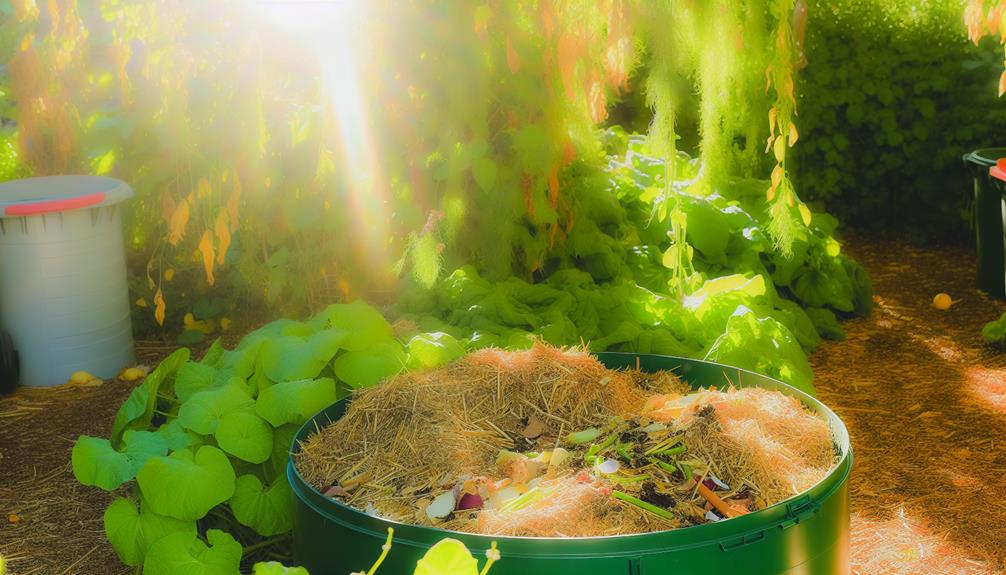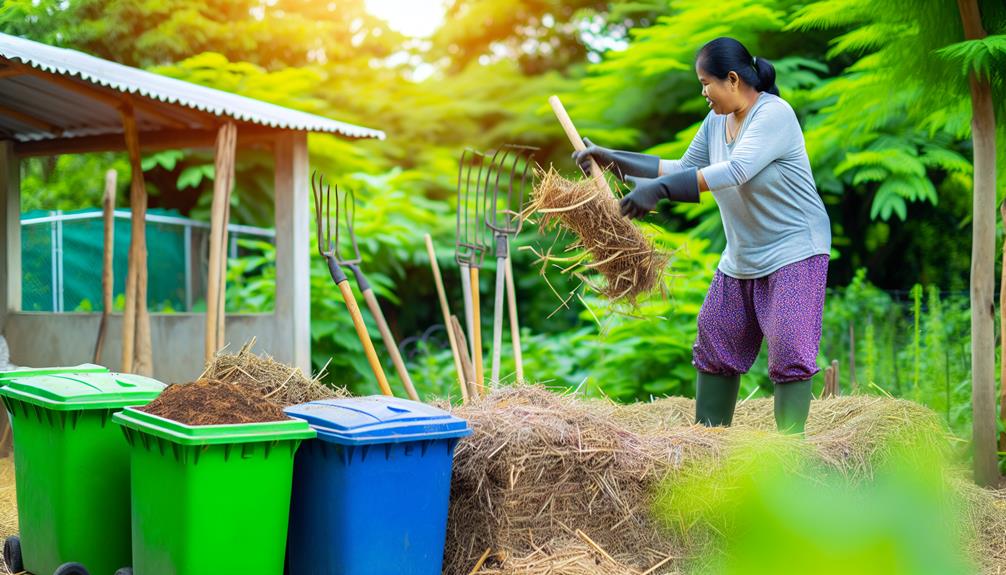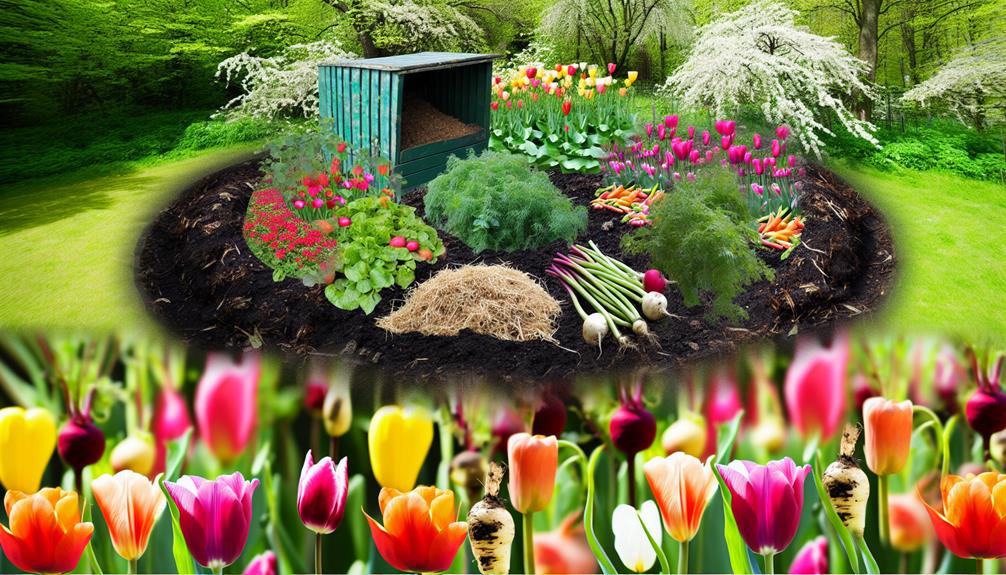

You can definitely compost straw, and it’s quite beneficial for your garden. Straw enriches soil with nutrients like nitrogen, phosphorus, and potassium, and improves soil structure and water retention. To compost straw effectively, chop it into smaller pieces for quicker decomposition.
Balance your compost by mixing straw with green materials to achieve a 30:1 carbon to nitrogen ratio. Keep the straw slightly damp and turn the pile regularly for proper aeration and moisture balance. Managing these factors will help create a nutrient-rich compost for your garden. To master this process fully, there’s more to learn about perfecting your compost setup.
Composting straw not only enriches your soil with essential nutrients but also improves its structure and water retention. When you incorporate straw into your compost, it breaks down into organic matter that boosts soil enrichment, making your garden healthier and more productive.
The decomposed straw adds valuable nutrients like nitrogen, phosphorus, and potassium, which are vital for plant growth. Plus, it enhances the soil’s texture, allowing for better root penetration and water retention.
By composting straw, you’re also engaging in waste reduction. Instead of discarding straw as waste, you’re turning it into a beneficial resource for your garden. This practice helps reduce the amount of organic matter ending up in landfills, contributing positively to the environment. It’s a simple yet effective way to manage garden waste and create a sustainable gardening practice.
To get started, layer straw with other compost materials like kitchen scraps, leaves, and grass clippings. Make sure to keep the compost pile moist and turn it regularly to speed up the decomposition process. Over time, you’ll see how composting straw transforms your soil, making it richer and more fertile for your plants.
Understanding the carbon to nitrogen ratio is essential when composting straw.
Straw is rich in carbon, so you’ll need to mix it with green materials like kitchen scraps or grass clippings to balance the ratio.
Aim for an ideal compost mix of about 30 parts carbon to 1 part nitrogen for efficient decomposition.
Straw has a high carbon to nitrogen ratio, usually around 80:1, making it an excellent carbon-rich material for composting. This high ratio means straw provides much-needed carbon, or ‘browns,’ in your compost pile.
By adding straw, you help balance the ‘greens,’ or nitrogen-rich materials, consequently creating an ideal environment for composting. This balance is essential to reduce your carbon footprint and minimize environmental impact.
To use straw effectively in composting, start by shredding or breaking it into smaller pieces. This increases the surface area, allowing microorganisms to break it down more efficiently. Mix the straw with other compost materials to ensure even decomposition. Ideally, alternating layers of carbon-rich materials like straw and nitrogen-rich materials will accelerate the composting process.
Achieving the perfect carbon to nitrogen ratio in your compost pile requires a careful balance of green materials, such as kitchen scraps and grass clippings, with carbon-rich straw. To create effective compost, you’ll need to combine these green wastes, which are rich in nitrogen, with the straw that’s high in carbon. This balance is essential for efficient decomposition and to avoid unpleasant odors.
Start by collecting your green waste. This includes items like vegetable peels, coffee grounds, and fresh grass clippings. Aim for a mix that’s roughly one part green materials to two parts straw. This ratio ensures that your compost pile remains aerated and allows microorganisms to thrive.
Layer your compost bin with alternating layers of green waste and straw. A good practice is to start with straw at the base to promote airflow. As you add green materials, make sure they’re evenly distributed. Turn the pile regularly to mix the materials and incorporate oxygen, which speeds up the composting process.
To create the ideal compost mix, aim for a carbon to nitrogen ratio of about 30:1. This balance guarantees that your compost decomposes efficiently, providing nutrient-rich material for your garden.
Carbon-rich materials, like straw, leaves, and cardboard, provide energy for microorganisms. Nitrogen-rich materials, such as kitchen scraps, grass clippings, and coffee grounds, supply the proteins and oils necessary for microbial growth.
When adding materials to your compost bins, alternate between carbon and nitrogen sources. For instance, you could layer straw (carbon) and kitchen scraps (nitrogen). This layering helps maintain the optimal ratio and prevents common composting issues like bad odors or slow decomposition.
Monitor your compost regularly. If it’s too wet or smells bad, add more carbon-rich materials. Conversely, if it’s too dry or not breaking down, add nitrogen-rich materials.
Using a pitchfork or compost aerator, turn the compost every few weeks to ensure even decomposition and proper aeration.
Maintaining the right carbon to nitrogen ratio in your compost bins isn’t difficult. With a little attention to detail and regular monitoring, you’ll produce high-quality compost that benefits your garden and reduces waste.
Also Read: Can You Compost Black-Eyed Peas?
Before you begin composting, make sure the straw is properly prepared to speed up the decomposition process. Start by chopping straw into smaller pieces, which will increase the surface area and make it easier for microbes to break it down. You can use garden shears or a mulching mower to achieve this. The smaller the pieces, the quicker they’ll decompose.

Next, consider the importance of straw layering. Layering straw helps maintain airflow within your compost pile, which is essential for aerobic decomposition. A good practice is to alternate layers of straw with other compost materials to create a balanced mix.
Here’s a quick reference table for preparing straw:
| Step | Action |
|---|---|
| Chopping Straw | Cut straw into smaller pieces using garden shears or a mulching mower. |
| Straw Layering | Alternate layers of straw with other compostable materials. |
| Moisture Check | Ensure straw is slightly damp, not soaking wet. |
| Turn Regularly | Turn the compost pile to maintain airflow and mix materials. |
| Monitor Heat | Check the temperature to ensure effective decomposition. |
When mixing straw with other materials, always strive for a balanced carbon-to-nitrogen ratio to guarantee efficient composting. Straw is high in carbon, so you’ll need to add nitrogen-rich materials like kitchen scraps, grass clippings, or manure to balance it out. The ideal ratio is roughly 30 parts carbon to 1 part nitrogen.
Layering methods can help you achieve this balance. Start with a layer of straw, then add a layer of nitrogen-rich material. Continue alternating layers, making sure each layer is a few inches thick. This method ensures that the compost pile gets enough air, helping microorganisms break down the materials efficiently.
If you want to speed up the composting process, consider using compost accelerators. These products contain beneficial bacteria and fungi that boost decomposition. You can find them at garden centers or make your own by adding a handful of garden soil to your pile.
To effectively manage moisture in your compost, you need to balance the straw’s inherent dryness with the right amount of water. Aim for a moisture level that feels like a damp sponge, not too wet to prevent mold growth.
Regularly monitor and adjust the water content to guarantee ideal decomposition.
Straw’s dryness can be a challenge in composting, but effectively managing moisture levels guarantees successful decomposition. Different straw types, such as wheat, oat, or barley, have distinct moisture absorption capabilities. Understanding these differences helps you balance the straw’s dryness, making sure your compost pile stays healthy and active.
To manage straw’s moisture, start by soaking it before adding it to your compost pile. Immerse the straw in water for a few hours, allowing it to absorb as much moisture as possible. This initial soaking step is important for jump-starting the decomposition process. Once added, regularly monitor the moisture levels in your compost. You want it to feel like a damp sponge—moist but not soggy.
Mixing straw with other compost materials, like kitchen scraps and green yard waste, also helps balance the moisture. These materials usually contain higher moisture content and can counteract straw’s inherent dryness.
Turn your compost pile frequently to ensure even distribution of moisture and aeration, promoting faster breakdown.
Maintaining ideal water content is essential for making sure your compost pile remains active and decomposes efficiently. When composting straw, achieving the right balance of moisture is vital. Straw can be quite dry, so you’ll need to manage its moisture retention and water absorption capabilities effectively.
Start by adding water to the straw before incorporating it into your compost pile. Moisten the straw until it feels like a wrung-out sponge. This ensures it’s damp enough to promote microbial activity without becoming waterlogged. Remember, too much water can lead to anaerobic conditions, slowing down decomposition.
Regularly check the moisture level of your compost pile. Squeeze a handful of compost material; if a few drops of water come out, you’ve got the right amount of moisture. If it’s too dry, sprinkle water over the pile and mix it well. If it’s too wet, add more dry materials like straw or shredded paper to absorb excess moisture.
Proper moisture management is crucial to prevent mold growth in your compost pile. To keep your compost healthy, you need to balance moisture levels and guarantee good air circulation. Start by checking the moisture content regularly, aiming for a damp sponge consistency. If it’s too wet, you risk mold growth; if it’s too dry, decomposition slows down.
Turn your compost frequently. This simple step promotes air circulation, which helps maintain ideal moisture levels and prevents mold development. Use a pitchfork or compost aerator to mix the pile thoroughly. This process introduces fresh oxygen, essential for aerobic decomposition.
Next, monitor the ingredients you add. Straw can retain moisture, so mix it with dry, carbon-rich materials like leaves or shredded paper. This balance helps regulate moisture by absorbing excess water, reducing mold risks.
Cover your compost pile with a breathable tarp or lid, especially during heavy rain. This cover prevents waterlogging while still allowing airflow. Remember, mold thrives in stagnant, damp environments, so maintaining proper moisture and ventilation is crucial.
Also Read: Can You Compost Cat Food?
To guarantee your composting straw breaks down effectively, regularly aerate and turn the pile. This process is vital to maintain proper oxygen levels, which are essential for microbial activity. The microorganisms responsible for decomposing straw thrive in an oxygen-rich environment. By turning the compost pile, you help distribute air evenly, promoting a healthy and active microbial community.
Start by using a pitchfork or compost aerator tool to turn the pile every week or so. Make sure you mix the outer layers with the inner layers, as this helps maintain a consistent temperature and moisture level throughout the pile. When the compost is well-aerated, it prevents anaerobic conditions, which can slow decomposition and cause unpleasant odors.
Incorporating straw into your compost pile is beneficial, but it does require consistent management. By committing to regular aeration and turning, you’ll foster a more efficient composting process. Your compost will break down faster, creating nutrient-rich soil for your garden.
Composting straw isn’t without its challenges, but understanding these issues can help you address them effectively.
One common challenge is the decomposition rate. Straw typically breaks down slower than other organic materials due to its high carbon content. To speed up the process, you need to balance it with nitrogen-rich materials like grass clippings or kitchen scraps. This balance guarantees that the straw decomposes at a more manageable pace.
Another issue you might face is pest problems. Straw can attract pests like rodents and insects if not managed properly. To minimize pest issues, make sure your compost pile reaches a high internal temperature. This not only helps with decomposition but also deters pests. Regularly turning the pile can also help keep pests at bay by maintaining an environment that’s less inviting to them.
Lastly, straw can become compacted, reducing aeration and slowing decomposition. To prevent this, mix the straw well with other compost materials and periodically fluff up the pile. This ensures that air can circulate, promoting faster breakdown and reducing the likelihood of pest infestations.
When dealing with issues in your straw compost, identifying the root cause quickly is crucial to maintaining an efficient composting process. If your compost isn’t breaking down as expected, start by examining the straw sources. Some straw might have been treated with pesticides, slowing the composting time. Make sure you’re using untreated, natural straw for the best results.
Check the moisture levels regularly. Straw can dry out quickly, so keep it damp but not soggy. Mixing in green materials like grass clippings can help balance moisture and nitrogen content, speeding up the composting process.
Here’s a quick troubleshooting guide:
| Problem | Solution |
|---|---|
| Compost too dry | Add water and mix thoroughly |
| Compost too wet | Incorporate dry materials like leaves or more straw |
| Slow decomposition | Add green materials for nitrogen and turn the pile frequently |
Also, pay attention to the composting time. Straw composting can take several months, especially in cooler climates. Regularly turning the pile and adding diverse organic materials can help accelerate the process. Always maintain a balance of carbon (from straw) and nitrogen (from greens) to keep your compost healthy and active. By addressing these common issues, you’ll foster a thriving compost pile that meets your gardening needs.
Also Read: Can You Compost Cabbage?
Once your straw compost is ready, you can use it to enrich garden soil, mulch plants, or create nutrient-dense potting mix. Incorporating your compost into your gardening routine guarantees you get the maximum benefits from your hard work.

Here are three practical ways to utilize your straw compost:
Straw composting can attract pests and rodents, but you can practice pest prevention and rodent control by maintaining a balanced and well-maintained compost pile. Keep the compost moist and regularly turned to deter unwanted visitors.
You’re probably wondering how long straw takes to decompose. Typically, it takes about six months to a year. This process enriches your soil and helps with moisture retention, making your garden thrive and feel like home.
You don’t have to chop straw before composting, but using cutting tools can speed up the process. Smaller pieces improve compost aeration, helping microbes break it down faster. Give it a try and share your results!
Yes, you can compost straw from animal bedding. It’s got great nutrient content, enriching your compost. Consider bedding alternatives like wood shavings or hay, but straw’s a solid choice for sustainable composting. Join the eco-friendly community!
When you compost straw, it should not generate unpleasant odors if you manage moisture and use proper aeration techniques. By doing this, you’ll guarantee a healthy composting process and foster a sense of community with fellow gardeners.
By composting straw, you’re enhancing your compost’s carbon content, which balances with nitrogen-rich materials for best decomposition. Make sure straw is chopped and mixed well with other compostables, maintaining proper moisture and aeration.
Turning the compost regularly prevents common issues like odor and pests. With these steps, you’ll produce rich, usable compost that benefits your garden.
Troubleshoot any problems promptly to keep the process efficient and effective. Happy composting!
